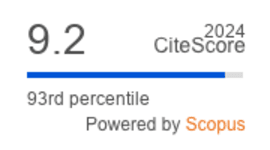Therapeutic Targeting of MOAP-1 in Cancer: A Systematic Review of Current Approaches and Future Directions
DOI:
https://doi.org/10.36877/pmmb.a0000387Abstract
The Modulator of Apoptosis 1 (MOAP-1) protein, a crucial regulator of apoptosis, has recently attracted considerable interest in oncology research. Its potential as a therapeutic target in bladder, breast, and non-small cell lung cancer (NSCLC) offers intriguing new therapeutic approaches. This comprehensive review consolidated work on MOAP-1's role in cancer biology, notably as a therapeutic target. A systematic review was conducted by searching digital databases for studies. Based on inclusion and exclusion criteria, ten articles were thoroughly assessed. Emerging evidence links MOAP-1 to bladder cancer chemosensitivity and MOAP-1-dependent chemosensitization of breast cancer mediated by phenylquinazoline derivatives. In addition, apoptosis in breast cancer cells was induced by α-mangostin, a potential therapeutic drug targeting MOAP-1 and BCL-XL interaction. Studies showed MOAP-1's importance in NSCLC, with its upregulation in the cancer cells as a potential treatment. This review also highlights the role of miR-25 as a cellular regulator of MOAP-1 and its implication for MOAP-1-mediated therapeutics. The intricate control of MOAP-1 in cancer highlights the need for more research to understand its function and regulation across cancer types completely. MOAP-1's tumor suppressor activity suggests it could be a therapeutic target, as evidenced by current research findings, which is likely to spur further research into MOAP-1-targeted cancer treatments. This systematic review fills a gap in the literature by bringing together a variety of study findings to promote a deeper understanding of MOAP-1 and its therapeutic potential.
Downloads
Published
How to Cite
Issue
Section
License
Copyright (c) 2023 Xinwei Koong, Keyun Look, Amar Daud Iskandar Abdullah, Kuan Onn Tan, Vasudevan Mani, Hooi-Leng Ser, Khag Wen Goh, Ali Saleh Alkhoshaiban, Long Chiau Ming

This work is licensed under a Creative Commons Attribution-NonCommercial 4.0 International License.
Author(s) shall retain the copyright of their work and grant the Journal/Publisher right for the first publication with the work simultaneously licensed under:
Creative Commons Attribution-NonCommercial 4.0 International (CC BY-NC 4.0). This license allows for the copying, distribution and transmission of the work, provided the correct attribution of the original creator is stated. Adaptation and remixing are also permitted.

This broad license intends to facilitate free access to, as well as the unrestricted reuse of, original works of all types for non-commercial purposes.
The author(s) permits HH Publisher to publish this article that has not been submitted elsewhere.



.png)

.jpg)
